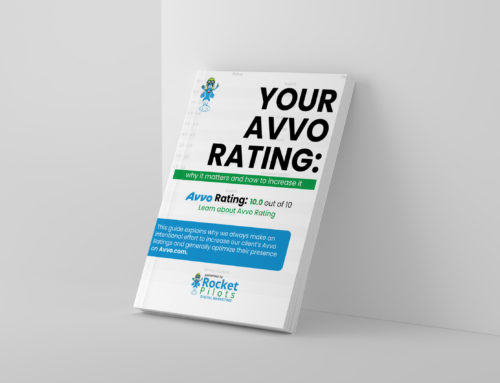Are you wondering how the new Google BERT update will affect your personal injury website? BERT is one of the most impactful updates related to the natural language processing of Google to date. It’s a clear indication that Google has become smarter when it comes to more specialized fields.
This is especially true for personal injury law firms where terms may be used that are not readily known outside this niche. The added layer of learning can help your personal injury website become easier to find without using exact keywords. Therefore, if one of your online marketing goals is to increase website visitors, Google BERT might be exactly what you need.
Here’s what you need to know about what does the BERT update means and how this exciting improvement will affect your personal injury website.
What Does The BERT Update Mean?
What does the BERT update mean? BERT is an acronym that means Bidirectional Encoder Representations from Transformers.
In other words, BERT tries to understand the context of search queries. This is done by the Transformers that try to understand words in a given sentence instead of looking at their meaning in isolation.
BERT comes in handy when interpreting search queries with prepositions. This helps Google provide more accurate and relevant results to searchers.
The Google BERT update was released on October 24, 2019, and it was reported that it will affect 1 in 10 search queries. The rollout was for English searches only but the company plans to impact other language queries in the future.
It’s the biggest update since RankBrain in 2015. Search queries are getting more conversational and as voice search grows, so does the need for more relevant results. BERT takes Google’s capabilities to the next level by understanding user intent behind a search query.
BERT is a component of Natural Language Processing (NLP) aimed at understanding conversational queries. NLP is made up of linguistics and machine learning. This makes it possible for communication between humans and computers as natural as possible.
Popular language apps such as Google Translate, Microsoft Word, Grammarly, and voice assistant devices utilize NLP technology.
What to Expect from BERT
So what does the Google BERT update look like in practice?
Google uses the following examples to help users understand its impact.
“Do estheticians stand a lot at work?” Previously, Google matched terms so the system would interpret the word “stand” as “stand-alone” Now BERT helps the system understand that stand a lot implies physical demand and the searcher asks if the esthetician has to be on their feet a lot.

How Does BERT Affect SEO?
Google’s BERT update analyzes search queries instead of web pages. It helps search understand the context of words, especially where prepositions matter to the meaning of a sentence. This helps users search in a more natural way.
Search intent is Google’s number one goal. If you want to succeed with content marketing and SEO, search intent should be a vital part of your approach. There are 3 types of search queries including informational, navigational, and transactional queries.
Informational search queries are for users looking for answers, educational materials, and resources to help them understand their problems better. BERT mostly impacts informational related keywords.
For instance, it could be someone who underwent a total hip replacement using defective metal-on-metal hip implants. Eventually, they started to experience complications such as adverse pain or swelling on the hip. So when they realize that all this suffering is due to the defective device, they will perform a search to learn how to sue for a defective hip replacement. That’s an informational search query.
Once they perform the search, they’ll find different law firm websites offering solutions. From here, they may search for a solution using a navigational query like. “metal on metal hip replacement lawsuits and settlements”
Once they figure out the exact solution, they may perform a transactional search query by clicking on the “Hire a product liability lawyer” button on your website to get assistance.
Google’s BERT update affects longer conversational queries where the context of words may be hard to understand. You’ll need to keep a closer watch on long-tail keywords in order to acquire organic traffic. You should also optimize for each type of search intent.
BERT also improves featured snippets to make it more relevant for users to create a better search experience. Google gives the example of the featured snippet for ” parking on a hill with no curb”.
Before the update, Google dismissed “no”. This mistake resulted in a negative search experience for users and increased bounce rates for sites. BERT fixes this issue to help search engines understand the context of this query and include results that include parking with no curb.
BERT and On-Page SEO
Since BERT aims to address searcher intent, your content needs to be more relevant for particular keywords. Long-tail keywords become more important because they focus on natural language.
In most cases, when your potential client performs a Google search related to their case or issue, they may not realize that they need a lawyer. Their search query will be in the form of a question or phrase. This is why targeting long-tail keywords are crucial.
Long-tail keywords involve highly specific searches that are relevant to your practice area. Some examples of long-tail searches your potential client could use include:
- Can a driver hit in a rear-end collision in Denver be held responsible?
- What do I do if I get hit by a driver in Arapahoe county?
If you’ve been optimizing your on-page SEO for voice search, BERT will give you a better outcome. This is because the voice search involves a conversational content structure.
The best on-page SEO strategy for BERT is to create valuable content that’s relevant to your potential clients. If you realize that your traffic has been affected since BERT was rolled out, then you should audit your content.
It’s also worth mentioning that BERT makes the search more specific and increases conversion. Therefore, losing a considerable amount of search traffic with BERT isn’t necessarily a bad thing. You lose the traffic that was increasing your bounce rate and ruining your user metrics.
What BERT is Not Good At
The BERT update has its fair share of shortcomings. According to fascinating research by Allyson Ettinger, she explores some critical areas where the BERT language model falls short.
There are two key areas BERT fails to hit the mark. This includes:
- Commonsense and pragmatic inference
- Negation
BERT struggles when it comes to grasping the context of words that have not been mentioned directly but inferred. For instance, a sentence such as, “ he complained that after she kissed him, he couldn’t get the red color off his face. He finally just asked her to stop wearing that ….”
You can easily guess that the missing word here is “lipstick” BERT fails to display the same level of sensitivity to this answer in what would be a commonsense scenario for a person.
The research also found that BERT completely failed to show a general understanding of negation. If you asked, “A robin is a…,” you’ll get many options like a bird, person, pigeon, or person.
However, when you search, “ a robin is not a …,” you’ll get the same results. This error brings confusion to a searcher who may not be familiar with the term.
Bert Myths
There’s a lot of misinformation surrounding BERT. Let’s now bust some of the ongoing myths about what BERT is and isn’t. Let’s break some of the myths people have been spreading.
BERT involves optimizing your site for long-tail queries
BERT is more focused on helping Google understand what a user means and connecting that search query to specific information on your site. Your site doesn’t have to be long-tail search-friendly.
The effect of BERT is quite small
Since BERT doesn’t shake up the keywords that matter, there’s a perception that the update is small. However, Google reported that this update affects one out of ten search queries. That’s quite a significant number.
BERT places more importance on stop words
To elaborate on BERT, Google uses examples with words like “from” and “to.” Some articles on the update claimed that stop words will become more important and should be included in URLs.
BERT’s core focus is making its search results relevant to searchers. This doesn’t mean that stop words have now become a Google ranking factor. It only means that with BERT, the search takes into consideration search queries that use stop words to be more specific and relevant to its users.
BERT is the biggest update of all time
In a press release issued by Google, they stated that they’re improving how Google understands queries. They also mentioned that this represented their biggest leap forward in five years and in the history of search.
The press release shows that BERT is one of their biggest improvements in a span of five years, not of all time. BERT is among other major updates such as Hummingbird, Panda, Penguin, and RankBrain.

What Could Google BERT Mean for Personal Injury Websites?
Potential clients often find your personal injury website through highly specific searches related to their case or current issue. They will use long-tail phrases as they perform a search.
You need to focus on creating content around long-tail keywords. They are more likely to engage with your potential clients and help you create better quality content for searchers.
When you do this, BERT will reward your site with better placement in search results for relevant queries. The BERT update creates a win-win scenario for you and your potential clients. If you develop high-quality content for your personal injury website, you’re likely to be found more easily.
On the other hand, your potential clients will get better answers to queries because search now better understands their intent. Google is better equipped to understand complex questions so they will get the best information as they seek legal redress.
BERT and a personal injury case scenario
A searcher might be looking for information about what to do when you’re involved in a car wreck and injuries don’t show up at once. If your personal injury website creates content around such topics, BERT will be able to point this searcher in your direction.
Let’s say that your web page content delves into details of crash injuries including how endorphins and adrenaline come into play and make head injuries or even soft tissue damage less obvious shortly after a crash. Your content becomes more helpful to this potential client. This shows that BERT serves to increase the visibility of sites for relevant queries.
Benefits of Google’s BERT update to personal injury law firms
As I mentioned earlier, most legal terms are not common knowledge. Sometimes a potential client may not even know that they need a lawyer when they encounter a problem. They just search for a medical condition or issue they are experiencing.
BERT makes the search more specific to address issues such as these for their users. The best way to work with BERT is to make sure your website offers detailed information that answers a question or addresses an issue thoroughly. This not only gives you a better chance with BERT but also helps you engage with your potential client.
This detailed information enables your potential clients to understand what’s going on as well as what to do next. This content starts to build trust with them even before they contact your office.
Using our previous example, the searcher might look for information about why they’re experiencing pain after an auto accident. They may have even more questions such as whether an accident that happened at a slow rate of speed could cause injuries.
Your content needs to address the impact of auto accidents that occur at a slow rate of speed. Once you get to your potential client’s pain point, they’ll be more inclined to hire you.
Can you Optimize for Google’s BERT Update?
The answer to this question can be best answered by Danny Sullivan, Google’s public search liaison. He tweeted that BERT is an extension of Google’s focus on great content. The only thing you can do is making sure that content on your pages matches the searcher intent.
To do this, improve writing for NLP. Here are some actionable steps you can take to optimize your content for NLP.
- Use a simple sentence structure to connect questions to answers. Just like the one or two sentences you’d expect Google Assistant to give you when you ask a question.
- Provide a precise answer to boost search relevance.
- Avoid antecedents that are not clear especially when using “it.”
- Cover secondary topics or additional searches your potential client might have on a given topic.
- Prioritize on readability.
- Add question keywords and search journey topics into your keyword research strategy.
Conclusion
If you have not focused on creating high-quality content for your personal injury website, now’s the time to start.
Working with a professional SEO service provider to put your content on the right side of BERT, contact us today to get help with creating long-tail keywords for every type of searcher intent as well as valuable content creation.





